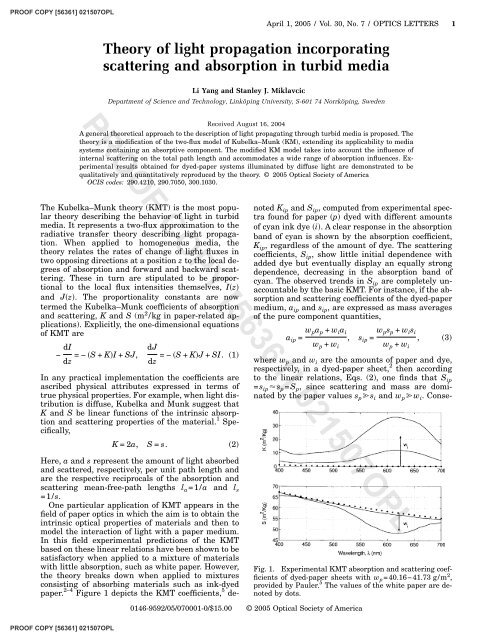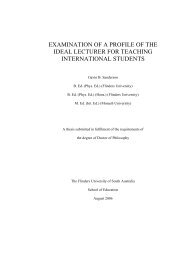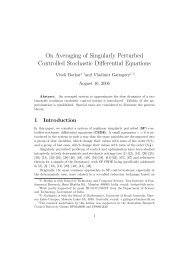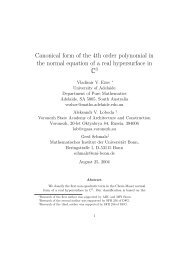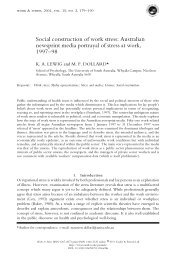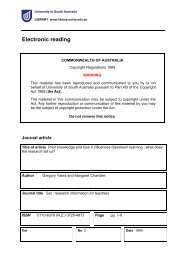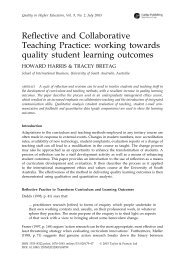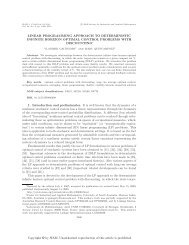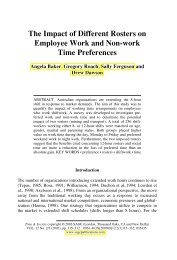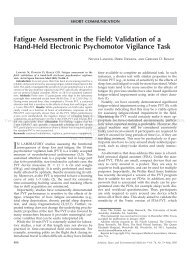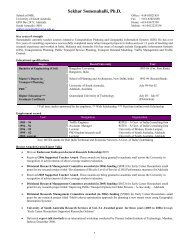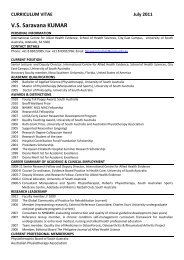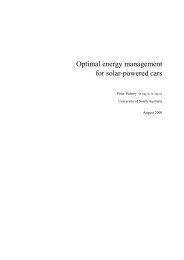A theory of light propagation incorporating scattering and absorption ...
A theory of light propagation incorporating scattering and absorption ...
A theory of light propagation incorporating scattering and absorption ...
Create successful ePaper yourself
Turn your PDF publications into a flip-book with our unique Google optimized e-Paper software.
PROOF COPY [56361] 021507OPL<br />
April 1, 2005 / Vol. 30, No. 7 / OPTICS LETTERS 1<br />
Theory <strong>of</strong> <strong>light</strong> <strong>propagation</strong> <strong>incorporating</strong><br />
<strong>scattering</strong> <strong>and</strong> <strong>absorption</strong> in turbid media<br />
Li Yang <strong>and</strong> Stanley J. Miklavcic<br />
Department <strong>of</strong> Science <strong>and</strong> Technology, Linköping University, S-601 74 Norrköping, Sweden<br />
PROOF COPY [56361] 021507OPL<br />
Received August 16, 2004<br />
A general theoretical approach to the description <strong>of</strong> <strong>light</strong> propagating through turbid media is proposed. The<br />
<strong>theory</strong> is a modification <strong>of</strong> the two-flux model <strong>of</strong> Kubelka–Munk (KM), extending its applicability to media<br />
systems containing an absorptive component. The modified KM model takes into account the influence <strong>of</strong><br />
internal <strong>scattering</strong> on the total path length <strong>and</strong> accommodates a wide range <strong>of</strong> <strong>absorption</strong> influences. Experimental<br />
results obtained for dyed-paper systems illuminated by diffuse <strong>light</strong> are demonstrated to be<br />
qualitatively <strong>and</strong> quantitatively reproduced by the <strong>theory</strong>. © 2005 Optical Society <strong>of</strong> America<br />
OCIS codes: 290.4210, 290.7050, 300.1030.<br />
The Kubelka–Munk <strong>theory</strong> (KMT) is the most popular<br />
<strong>theory</strong> describing the behavior <strong>of</strong> <strong>light</strong> in turbid<br />
media. It represents a two-flux approximation to the<br />
radiative transfer <strong>theory</strong> describing <strong>light</strong> <strong>propagation</strong>.<br />
When applied to homogeneous media, the<br />
<strong>theory</strong> relates the rates <strong>of</strong> change <strong>of</strong> <strong>light</strong> fluxes in<br />
two opposing directions at a position z to the local degrees<br />
<strong>of</strong> <strong>absorption</strong> <strong>and</strong> forward <strong>and</strong> backward <strong>scattering</strong>.<br />
These in turn are stipulated to be proportional<br />
to the local flux intensities themselves, Iz<br />
<strong>and</strong> Jz. The proportionality constants are now<br />
termed the Kubelka–Munk coefficients <strong>of</strong> <strong>absorption</strong><br />
<strong>and</strong> <strong>scattering</strong>, K <strong>and</strong> S (m 2 /kg in paper-related applications).<br />
Explicitly, the one-dimensional equations<br />
<strong>of</strong> KMT are<br />
− dI<br />
dJ<br />
=−S + KI + SJ, =−S + KJ + SI. 1<br />
dz dz<br />
In any practical implementation the coefficients are<br />
ascribed physical attributes expressed in terms <strong>of</strong><br />
true physical properties. For example, when <strong>light</strong> distribution<br />
is diffuse, Kubelka <strong>and</strong> Munk suggest that<br />
K <strong>and</strong> S be linear functions <strong>of</strong> the intrinsic <strong>absorption</strong><br />
<strong>and</strong> <strong>scattering</strong> properties <strong>of</strong> the material. 1 Specifically,<br />
K =2a, S = s. 2<br />
Here, a <strong>and</strong> s represent the amount <strong>of</strong> <strong>light</strong> absorbed<br />
<strong>and</strong> scattered, respectively, per unit path length <strong>and</strong><br />
are the respective reciprocals <strong>of</strong> the <strong>absorption</strong> <strong>and</strong><br />
<strong>scattering</strong> mean-free-path lengths l a =1/a <strong>and</strong> l s<br />
=1/s.<br />
One particular application <strong>of</strong> KMT appears in the<br />
field <strong>of</strong> paper optics in which the aim is to obtain the<br />
intrinsic optical properties <strong>of</strong> materials <strong>and</strong> then to<br />
model the interaction <strong>of</strong> <strong>light</strong> with a paper medium.<br />
In this field experimental predictions <strong>of</strong> the KMT<br />
based on these linear relations have been shown to be<br />
satisfactory when applied to a mixture <strong>of</strong> materials<br />
with little <strong>absorption</strong>, such as white paper. However,<br />
the <strong>theory</strong> breaks down when applied to mixtures<br />
consisting <strong>of</strong> absorbing materials such as ink-dyed<br />
paper. 2–4 Figure 1 depicts the KMT coefficients, 5 denoted<br />
K ip <strong>and</strong> S ip , computed from experimental spectra<br />
found for paper p dyed with different amounts<br />
<strong>of</strong> cyan ink dye i. A clear response in the <strong>absorption</strong><br />
b<strong>and</strong> <strong>of</strong> cyan is shown by the <strong>absorption</strong> coefficient,<br />
K ip , regardless <strong>of</strong> the amount <strong>of</strong> dye. The <strong>scattering</strong><br />
coefficients, S ip , show little initial dependence with<br />
added dye but eventually display an equally strong<br />
dependence, decreasing in the <strong>absorption</strong> b<strong>and</strong> <strong>of</strong><br />
cyan. The observed trends in S ip are completely unaccountable<br />
by the basic KMT. For instance, if the <strong>absorption</strong><br />
<strong>and</strong> <strong>scattering</strong> coefficients <strong>of</strong> the dyed-paper<br />
medium, a ip <strong>and</strong> s ip , are expressed as mass averages<br />
<strong>of</strong> the pure component quantities,<br />
a ip = w pa p + w i a i<br />
, s ip = w ps p + w i s i<br />
, 3<br />
w p + w i w p + w i<br />
where w p <strong>and</strong> w i are the amounts <strong>of</strong> paper <strong>and</strong> dye,<br />
respectively, in a dyed-paper sheet, 2 then according<br />
to the linear relations, Eqs. (2), one finds that S ip<br />
=s ip s p =S p , since <strong>scattering</strong> <strong>and</strong> mass are dominated<br />
by the paper values s p s i <strong>and</strong> w p w i . Conse-<br />
Fig. 1. Experimental KMT <strong>absorption</strong> <strong>and</strong> <strong>scattering</strong> coefficients<br />
<strong>of</strong> dyed-paper sheets with w p =40.16−41.73 g/m 2 ,<br />
provided by Pauler. 5 The values <strong>of</strong> the white paper are denoted<br />
by dots.<br />
0146-9592/05/070001-0/$15.00 © 2005 Optical Society <strong>of</strong> America<br />
PROOF COPY [56361] 021507OPL
PROOF COPY [56361] 021507OPL<br />
2 OPTICS LETTERS / Vol. 30, No. 7 / April 1, 2005<br />
quently, at complete odds with observations, the<br />
KMT predicts no variation in <strong>scattering</strong> with ink content<br />
(see dotted lines in Fig. 1). Various strategies for<br />
removing these <strong>and</strong> other shortcomings <strong>of</strong> KMT, by<br />
expressing K <strong>and</strong> S as sophisticated functions <strong>of</strong> a<br />
<strong>and</strong> s, have been mapped out. 6–8 However, the proposed<br />
relations vary across fields <strong>of</strong> application, with<br />
no apparent consensus on assumptions that should<br />
be made.<br />
Recently, we proposed a modification <strong>of</strong> the KMT to<br />
explicitly include the effect <strong>of</strong> <strong>light</strong> <strong>scattering</strong> on the<br />
true optical path length. 9 The fundamental revisions<br />
<strong>of</strong> Eqs. (2) are mathematically expressed as 9<br />
K = a, S = s/2. 4<br />
The quantity is a factor depending solely on <strong>light</strong><br />
distribution I as =I/I 0 cos −1 d. For diffuse<br />
<strong>light</strong> distribution, =2. The factor , called the<br />
<strong>scattering</strong>-induced path variation (SIPV), is a new<br />
development <strong>and</strong> appears in order to account for the<br />
effect <strong>of</strong> <strong>scattering</strong> on the true path length. 9 depends<br />
implicitly on the extents <strong>of</strong> both <strong>light</strong> <strong>absorption</strong><br />
<strong>and</strong> <strong>scattering</strong> in the medium <strong>and</strong> is simply defined<br />
as the ratio <strong>of</strong> average total path length L to the<br />
length <strong>of</strong> the corresponding displacement R (see<br />
Fig. 2):<br />
L/R.<br />
5<br />
For a strongly absorbing medium an expression in<br />
terms <strong>of</strong> physical properties,<br />
s/a 1/2 ,<br />
6<br />
was derived. In Yang <strong>and</strong> Kruse 9 it was also shown<br />
that inclusion <strong>of</strong> the SIPV factor brings the KMT<br />
qualitatively back in line with experimental observations.<br />
However, the assumption <strong>of</strong> strong <strong>absorption</strong><br />
that leads to expression (6) greatly exaggerates the<br />
quantitative absorptive influence <strong>of</strong> the ink dye. 9 To<br />
alleviate this problem, we present here a new <strong>and</strong><br />
more widely applicable expression for the SIPV factor<br />
that is both qualitatively <strong>and</strong> quantitatively in agreement<br />
with the experiment.<br />
For paper illuminated from above, the upward reflected<br />
<strong>light</strong> is due to either bulk scatterers or boundary<br />
interfaces. Because <strong>of</strong> <strong>scattering</strong>, photons propagate<br />
in a zig-zag fashion in the medium, as suggested<br />
by Fig. 2. If a photon is scattered N times, counted<br />
from turning point B to exit point C, the start-to-end<br />
displacement vector will be R= N<br />
n=1 r n , <strong>and</strong> the total<br />
photon path length is a sum <strong>of</strong> the lengths <strong>of</strong> the individual<br />
displacements. In the mean, the total path<br />
length will then be approximately N times the mean<br />
free path between scatterers; that is,<br />
L Nl s .<br />
7<br />
Within this same model <strong>of</strong> isotropic <strong>and</strong> chaotic <strong>scattering</strong><br />
the root-mean-square displacement is then<br />
statistically<br />
R R 2 1/2 = N n=1 r 2 n 1/2 Nls . 8<br />
Here denote an average. On the other h<strong>and</strong>, the<br />
mean displacement length averaged over all possible<br />
directions in the upper hemisphere can also be computed<br />
by 9 R R = 1 I D<br />
d = D.<br />
I 0 cos 9<br />
Equating the last two results gives the number <strong>of</strong><br />
<strong>scattering</strong> events:<br />
N = 2 D 2 /l s 2 .<br />
10<br />
The new <strong>and</strong> more general expression for the SIPV<br />
factor is then<br />
= sD.<br />
11<br />
Clearly important for determining <strong>and</strong> the amount<br />
<strong>of</strong> reflected <strong>light</strong> is average depth D <strong>of</strong> the turning<br />
points, defined in Fig. 2. Fortunately, this quantity<br />
can be determined self-consistently with only the<br />
KMT.<br />
Let the incident <strong>light</strong> intensity be I 0 . The general<br />
solutions <strong>of</strong> the KMT differential equations [Eqs. (1)],<br />
subject to the boundary conditions (i.e., boundary reflection<br />
at z=0 <strong>and</strong> z=−w p interfaces is negligible; extension<br />
to cases with boundary reflection is straightforward<br />
but tedious), are<br />
Iz = b 1 expAz/R + R b 2 exp− Az, 12<br />
Jz = b 1 expAz + b 2 exp− Az<br />
PROOF COPY [56361] 021507OPL<br />
where A=K 2 +2KS 1/2 <strong>and</strong> R =S+K−A/S <strong>and</strong><br />
b 1 =<br />
I 0 R <br />
1 − R 2 exp− 2Aw p , b 2 = − I 0R exp− 2Aw p <br />
1 − R 2 exp− 2Aw p .<br />
Fig. 2.<br />
layer.<br />
Schematic diagram <strong>of</strong> <strong>light</strong> <strong>scattering</strong> in a medium<br />
Since Jz represents the number <strong>of</strong> (reflected) photons<br />
per unit area per unit time traveling upward at<br />
an arbitrary position z, average depth D <strong>of</strong> photons<br />
that undergo reflection <strong>and</strong> exit from the upper surface<br />
is given by<br />
PROOF COPY [56361] 021507OPL
PROOF COPY [56361] 021507OPL<br />
April 1, 2005 / Vol. 30, No. 7 / OPTICS LETTERS 3<br />
0<br />
D = −−w p<br />
0<br />
−w p<br />
Jzzdz<br />
Jzdz<br />
= 1 − 2Aw p exp− Aw p − exp− 2Aw p <br />
A1 − 2 exp− Aw p + exp− 2Aw p .<br />
13<br />
D depends on the geometric thickness <strong>of</strong> the layer,<br />
w p , <strong>and</strong> the KMT coefficients <strong>of</strong> <strong>absorption</strong> <strong>and</strong> <strong>scattering</strong>,<br />
K <strong>and</strong> S, through the parameter A=K 2<br />
+2KS 1/2 . When the media layer is optically thick,<br />
Aw p 1, Eq. (13) simplifies to D1/A, leading to the<br />
equation<br />
= s 2 /a 2 + as 1/4<br />
14<br />
for the SIPV factor. A number <strong>of</strong> limits are worth noting<br />
here. For a relatively high-absorbing low<strong>scattering</strong><br />
medium, as, the dependence derived<br />
earlier, s/a 1/2 , is regained. Alternatively, a high<br />
value is expected for a relatively low-absorbing<br />
high-<strong>scattering</strong> medium, as; explicitly =s/a 1/4<br />
1. Note that in all the cases some <strong>absorption</strong> is essential<br />
for a consistent <strong>and</strong> meaningful evaluation <strong>of</strong><br />
the <strong>theory</strong>. For that matter, <strong>absorption</strong> is implicitly<br />
inherent in the KMT also. Because no special assumptions<br />
were made about the medium, the above<br />
results apply to any type <strong>of</strong> mixed-media system.<br />
Equation (11), with D given by Eq. (13), is a general<br />
expression for the SIPV factor. When the layer<br />
thickness <strong>and</strong> the KMT coefficients are known from<br />
reflection <strong>and</strong> transmission measurements, found say<br />
with diffuse <strong>light</strong> illumination, the SIPV factor can<br />
be computed directly by =2SD 1/2 . Then, knowing<br />
the KMT coefficients <strong>and</strong> the SIPV factor, one can<br />
compute the intrinsic <strong>absorption</strong> <strong>and</strong> <strong>scattering</strong> coefficients,<br />
a <strong>and</strong> s, with Eqs. (4).<br />
We illustrate the effectiveness <strong>of</strong> the new approach<br />
in reproducing experimental findings by applying the<br />
revised KMT to the experimental system represented<br />
in Fig. 1. This dyed-paper medium is typical <strong>of</strong> a system<br />
that has thus far eluded the KMT. 2,3<br />
In the simulation we adopt the nominal values <strong>of</strong><br />
w p =40 g/m 2 <strong>and</strong> =2 (diffuse <strong>light</strong> distribution). The<br />
KMT coefficients <strong>of</strong> paper, K p <strong>and</strong> S p , <strong>and</strong> dye, K i <strong>and</strong><br />
S i , are first computed from experimental spectra for<br />
pure paper <strong>and</strong> pure ink systems, 10 respectively, using<br />
the st<strong>and</strong>ard KMT. a p , s p , a i , <strong>and</strong> s i are then determined<br />
with Eqs. (4). The SIPV factor, ip , <strong>and</strong> the<br />
KMT coefficients <strong>of</strong> the dyed-paper, K ip <strong>and</strong> S ip , are<br />
then computed iteratively with Eqs. (3), (4), (11), <strong>and</strong><br />
(13). For details see our forthcoming paper.<br />
The results <strong>of</strong> the simulations <strong>of</strong> systems <strong>of</strong> dyed<br />
paper containing different amounts <strong>of</strong> dye are shown<br />
in Fig. 3. Overall, the results compare favorably with<br />
the experimental observations. Since paper undergoes<br />
little <strong>absorption</strong> a p 0, dye induces little <strong>scattering</strong><br />
s i 0, <strong>and</strong> w p w i , one finds from Eqs. (3),<br />
(4), <strong>and</strong> (11) that K ip 2 ip w i a i , S ip ip s p , <strong>and</strong> ip<br />
2s p D ip . Hence K ip is proportional to the amount <strong>of</strong><br />
Fig. 3. Predictions <strong>of</strong> the KMT <strong>absorption</strong> <strong>and</strong> <strong>scattering</strong><br />
coefficients <strong>of</strong> dyed paper, with w p =40 g/m 2 <strong>and</strong> w i<br />
=0.005,0.01,0.02,0.05,0.1,0.2 g/m 2 . The values <strong>of</strong> white<br />
paper are denoted by dots.<br />
dye, w i , <strong>and</strong> the dependence <strong>of</strong> S ip on the degree <strong>of</strong><br />
dyeing arises essentially through ip , which is proportional<br />
to D ip . In turn, D ip , the average depth that<br />
photons reach in the mixed medium before exiting<br />
the illuminated surface, depends on the relative<br />
strengths <strong>of</strong> <strong>absorption</strong> <strong>and</strong> <strong>scattering</strong> as well as the<br />
layer thicknesses. As the amount <strong>of</strong> the (absorbing)<br />
dye increases, the depth to which photons will survive<br />
without being absorbed decreases. This causes a<br />
reduction in ip <strong>and</strong> therefore a reduction in S ip<br />
within the <strong>absorption</strong> b<strong>and</strong> <strong>of</strong> the dye. The predicted<br />
trend in S ip is completely in line with the experiments<br />
shown in Fig. 1 <strong>and</strong> not featured by the st<strong>and</strong>ard<br />
KMT. Note that when the amount <strong>of</strong> dye is<br />
small, D ip is dominated by the thickness <strong>of</strong> the paper<br />
layer, w p . ip <strong>and</strong> hence S ip then remain nearly independent<br />
<strong>of</strong> dye, as in the experiments. In such cases,<br />
Eqs. (4) predict similar results to those <strong>of</strong> st<strong>and</strong>ard<br />
KMT [Eqs. (2)], which is known to apply well to systems<br />
with little <strong>absorption</strong>.<br />
L. Yang’s e-mail address is liyan@itn.liu.se.<br />
References<br />
1. P. Kubelka <strong>and</strong> F. Munk, Z. Tech. Phys. (Leipzig) 12,<br />
593 (1931).<br />
2. M. Rundlöf <strong>and</strong> J. A. Bristow, J. Pulp Pap. Sci. 23,<br />
J220 (1997).<br />
3. W. J. Foote, Pap. Trade J. 109, 333 (1939).<br />
4. J. A. Van den Akker, in Modern Aspects <strong>of</strong> Reflectance<br />
Spectroscopy, W. W. Wendl<strong>and</strong>t, ed. (Plenum, New<br />
York, 1968).<br />
5. N. Pauler (private communication). Similar<br />
experimental results may be found in Ref. 2.<br />
6. B. J. Brinkworth, Appl. Opt. 11, 1434 (1972).<br />
7. B. Philips-Invernizzi, D. Dupont, <strong>and</strong> C. Caze, Opt.<br />
Eng. (Bellingham) 40, 1082 (2001).<br />
8. J. F. Bloch <strong>and</strong> R. S’eve, Color Res. Appl. 28, 227<br />
(2003).<br />
9. L. Yang <strong>and</strong> B. Kruse, J. Opt. Soc. Am. A 21, 1933<br />
(2004).<br />
10. L. Yang, J. Opt. Soc. Am. A 20, 1149 (2003).<br />
PROOF COPY [56361] 021507OPL<br />
PROOF COPY [56361] 021507OPL


